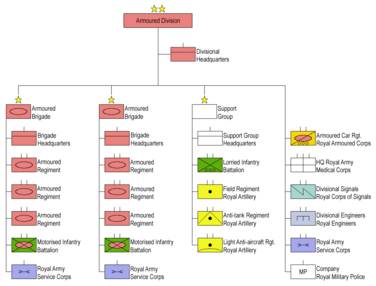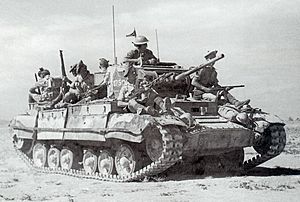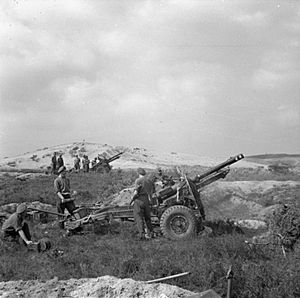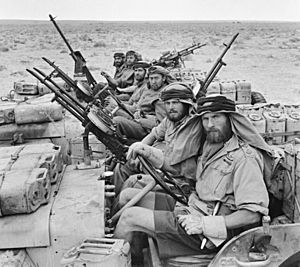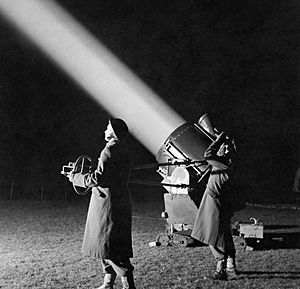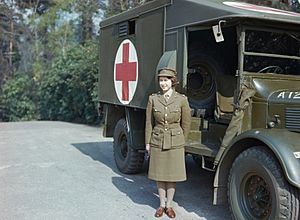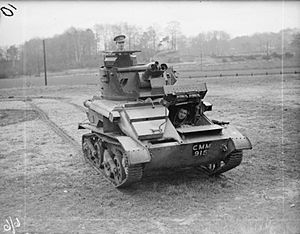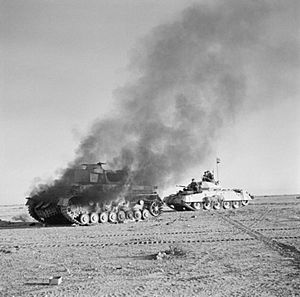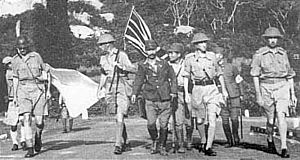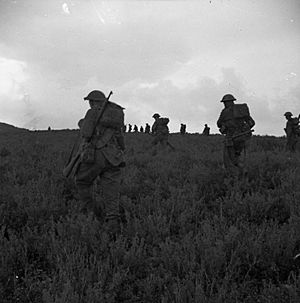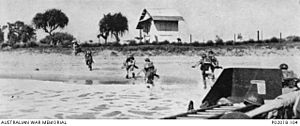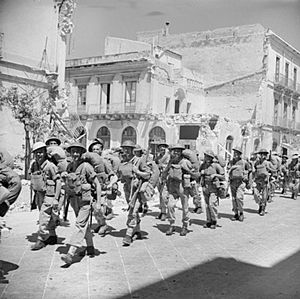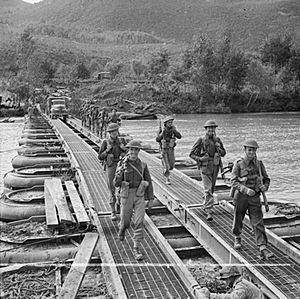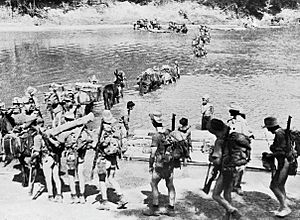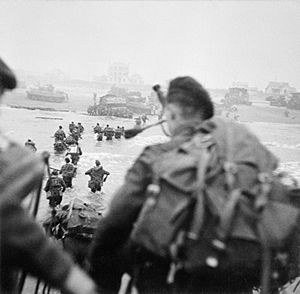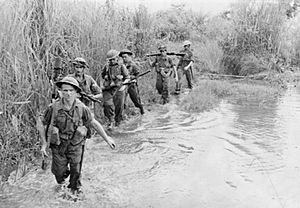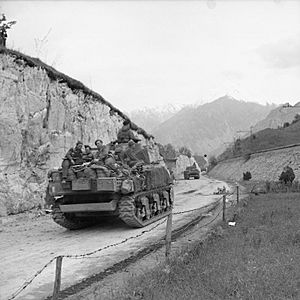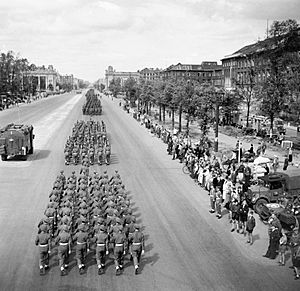British Army during the Second World War facts for kids
When World War II began in September 1939, the British Army was a small group of professional soldiers who had volunteered to serve. It was much smaller than the armies of its enemies, just like it had been at the start of World War I in 1914. It quickly became clear that the British Army wasn't ready or well-equipped for a war against many enemies on different battlefields.
In the early years of the war, from 1940 to 1942, the British Army often lost battles. But from late 1942, starting with the Second Battle of El Alamein, things changed. The British Army started winning more often. This was partly because the Soviet Union and the United States joined the war in 1941. Also, the secret Enigma code was cracked that same year.
A big reason for the change was that the British Army itself became much stronger. It got better equipment, better leaders, and better training. They also used conscription, which meant many more people joined the army. This allowed the army to grow into huge forces. New special groups were also created, like the Special Air Service (SAS), Special Boat Service (SBS), Commandos, and the Parachute Regiment. By the end of the war in September 1945, over 3.5 million men and women had served in the British Army. Around 720,000 of them were injured or killed.
Contents
How the British Army Fought in World War II
The British Army fought all over the world. This included Europe in 1940. After the Dunkirk evacuation in France, the army fought in the Middle East and in the Burma Campaign.
After many tough times, the British Army and its Allies started to win. This began with a victory in the Tunisian Campaign in North Africa in May 1943. Then, Italy was forced to surrender after the Allies invaded Sicily and mainland Italy in 1943.
In 1944, the British Army returned to France. With its Allies, they pushed the German Army back into Germany. In East Asia, the Japanese Army was pushed back from the Indian border into eastern Burma. By 1945, both the German and Japanese Armies were defeated and gave up.
What the First World War Taught the Army
The British Army learned a lot from the huge losses in World War I. Soldiers and the public didn't want to see so many lives lost again. So, the army tried to avoid heavy casualties. They studied the lessons from the First World War and developed new plans for future wars.
However, money was tight. The Royal Navy got most of the defense budget. The Royal Air Force (RAF) also got money to build bombers and later, radar helped them get more funds for fighter planes. The army didn't get as much money, and it wasn't until 1938 that large armored units were formed.
Alan Brooke, a top general from 1941, often wrote in his diary about not having enough good leaders. He thought this was because so many brave officers were lost in the First World War. He felt this shortage of leaders was a big problem for all parts of the military and even for politicians.
How the Army Was Set Up
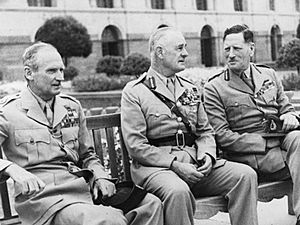
Army Size and Conscription
When World War II started, the British Army had about 892,000 officers and men. This included both full-time soldiers and part-time Territorial Army (TA) members. Only two armored divisions had been formed, compared to Germany's seven.
In May 1939, the Military Training Act 1939 introduced limited conscription. This meant men aged 20 to 22 had to do six months of military training. When war was declared in September 1939, the National Service (Armed Forces) Act 1939 made it law for all fit men aged 18 to 41 to register for training.
By the end of 1939, the British Army had grown to 1.1 million men. By June 1945, it reached its peak with 2.9 million men. In total, about three million people served in the army during the war.
By 1944, Britain faced a shortage of soldiers. Even though fewer soldiers were lost than expected in the Normandy Campaign, overall losses were still high. Some infantry divisions were even disbanded to provide replacements for other units. Many men from the RAF and Royal Artillery were moved to the infantry, where most of the fighting and casualties happened.
Infantry Divisions
During the war, the British Army created 43 infantry divisions. Not all of them existed at the same time. Some were just for training.
In 1939, an infantry division had about 13,863 men. By 1944, this grew to 18,347 men. A 1944 division usually had three infantry brigades. It also had a machine gun battalion, a reconnaissance regiment, and a large artillery group. This group included field guns, anti-tank guns, and anti-aircraft guns. Engineers, transport, medical, and signals units also supported the division.
Armored Divisions
At the start of the war, Britain had only two armored divisions. These were the 1st Armoured Division and the 7th Armoured Division. During the war, nine more armored divisions were created.
The way armored divisions were organized changed several times. By 1944, a division had an armored brigade with three armored regiments and a motorized infantry battalion. It also had an infantry brigade with three motorized infantry battalions. Support troops included armored cars, reconnaissance units, and artillery.
Artillery
The Royal Artillery was a very large part of the army. They were in charge of all types of guns: field, medium, heavy, mountain, anti-tank, and anti-aircraft.
The main field gun was the 25-pounder. It could fire shells up to 13,400 meters. It was also good at firing directly at tanks until better anti-tank guns arrived. At first, there weren't many 25-pounders, so older 18-pounder guns were also used.
A key part of artillery was the Forward Observation Officer (FOO). This officer would direct the gun fire. Unlike other armies, a British FOO could demand fire support from many guns, not just their own. This made British artillery very flexible and quick.
Medium artillery used older guns until 1941, when the 4.5-inch Medium gun arrived. This was followed by the 5.5-inch Medium gun in 1942. Large groups of artillery, called Army Group Royal Artillery (AGRA), were formed. These groups controlled medium and heavy artillery and supported entire corps.
Each division also had an anti-tank regiment. At first, they used the 2-pounder gun. But as tanks got stronger, this gun became outdated. The more powerful 6-pounder arrived in 1942. Even stronger, the 17-pounder gun was designed to take on heavy German tanks like the Tiger and Panther.
Light anti-aircraft regiments used Bofors 40 mm guns. These guns helped protect against enemy aircraft.
Special Forces
The first special raiding groups were the Independent Companies. They were meant to raid behind German lines in Norway. Later, the British Commandos were formed in 1940. They carried out raids on the German-occupied coast, like the famous St Nazaire Raid.
Inspired by German paratroopers, Winston Churchill asked for a similar elite force. This led to the creation of The Parachute Regiment. By the end of the war, they had 17 battalions. They were key parts of the 1st and 6th airborne divisions.
Other special units included the Long Range Desert Group, which gathered information behind enemy lines in North Africa. The Special Air Service (SAS) was formed in 1941 for raiding missions. Popski's Private Army also worked behind enemy lines. The Special Boat Service (SBS) was formed from a commando unit.
A secret group called the Auxiliary Units was trained to resist if Britain was invaded. They were well-equipped and hidden. The Auxiliary Territorial Service Searchlight Unit also played a vital role.
Auxiliary Territorial Service (ATS)
The Auxiliary Territorial Service (ATS) was the women's part of the British Army during World War II. It started in 1938. Women could join to work as cooks, clerks, and storekeepers. Many ATS members also worked with artillery units, helping with guns, searchlights, and barrage balloons. A famous ATS member was Princess Elizabeth (who later became Queen Elizabeth II). She trained as a driver and mechanic.
Home Guard
The Home Guard was formed in May 1940. Civilians aged 17 to 65 who were not in military service were asked to join. Over 250,000 people signed up in the first week! By July, there were 1.5 million volunteers. They were not paid and helped defend Britain. They were given old rifles from Canada and the United States. The Home Guard was officially stood down in December 1944.
Comparing Equipment
The British Army used two main types of tanks: slow, heavily armed infantry tanks and faster, lighter cruiser tanks. The cruiser tanks were meant to operate on their own. German tanks like the Panzer III and Panzer IV were often better than British tanks at the start of the war.
By 1942, American tanks like the Grant and Lend-Lease Sherman tanks joined the British forces. These tanks were much better. A British version of the Sherman, called the Sherman Firefly, was the only tank that could defeat powerful German tanks like the Panther, Tiger I, and Tiger II from a distance.
The main British anti-tank gun was the Ordnance QF 2-pounder. It was good at first but became less effective as German tanks got stronger. The 6-pounder replaced it in 1942. The powerful 17-pounder anti-tank gun, introduced in 1943, could finally knock out the heaviest German tanks.
After the evacuation from France, Britain lost many guns. But a new program quickly produced many new artillery pieces, which became very important from 1942 onwards.
For infantry, the German MP 38/40 submachine gun surprised the British. The British then developed the simple-to-make Sten gun, producing millions of them. The British Bren light machine gun was good, but the German MG 42 could fire much faster. The standard British rifle was the Lee–Enfield Rifle, No. 4 Mk I, which was better than the standard German rifle, the Karabiner 98k.
British medical services were very good. They had better staff, equipment, and medicines. This meant more British soldiers could stay in the fight compared to their enemies.
Training During the War
The army had many training pamphlets and instructions. These documents helped soldiers learn new tactics and how to use new equipment. They were updated as the war went on and new lessons were learned from battles. However, sometimes new technology and tactics changed so fast that the written instructions became outdated quickly.
British Armies in World War II
First Army
The First Army was formed in November 1942. It commanded British and American forces during the Operation Torch landings in North Africa.
Second Army
The Second Army was led by Lieutenant-General Sir Miles Dempsey. It was in charge of the British and Canadian landings in Normandy on D-Day in June 1944.
Eighth Army
The Eighth Army was formed in September 1941. It fought in North Africa, starting with the Second Battle of El Alamein. It then advanced through Libya and Tunisia. The Eighth Army later took part in the invasions of Sicily and Italy.
Ninth Army
The Ninth Army was formed in November 1941. It controlled British and Commonwealth forces in the eastern Mediterranean, including Palestine and Transjordan.
Tenth Army
The Tenth Army was formed in Iraq. Its main job was to protect the supply routes to the Soviet Union and the oilfields in Persia and Iraq.
Twelfth Army
The Twelfth Army was reformed in May 1945 to take over operations in Burma.
Fourteenth Army
The Fourteenth Army was a large force with soldiers from many Commonwealth countries, including Britain, India, and African nations. It was often called the "Forgotten Army" because its battles in the Burma Campaign were not as well-known. It was the largest Commonwealth Army during the war, with almost a million men by late 1944.
Army Groups
Eleventh Army Group
The 11th Army Group was set up in November 1943 to command land forces in South East Asia.
Fifteenth Army Group
The 15th Army Group was formed in May 1943 after the Axis forces surrendered in Tunisia. It was responsible for the Allied invasion of Sicily in July 1943.
Eighteenth Army Group
The 18th Army Group was created in early 1943. It helped coordinate the First and Eighth Armies as they closed in on Axis forces in the Tunisia Campaign.
Twenty First Army Group
The 21st Army Group initially controlled all ground forces for Operation Overlord (the D-Day landings). It included the British Second Army and the First Canadian Army. After Germany surrendered, the 21st Army Group became the headquarters for the British zone of occupation in Germany, known as the British Army of the Rhine (BAOR).
Key Campaigns
1939–1940: Early Battles
After war was declared, the British Expeditionary Force (BEF) was sent to France. It started with about 160,000 men.
In May 1940, the German Army invaded France. The Germans advanced very quickly. Most of the BEF had to withdraw to Dunkirk. Over 330,000 British and French troops were rescued by June 4. They had to leave most of their equipment behind. The BEF suffered about 68,000 casualties, with many taken prisoner.
The British Army also fought in the Norwegian Campaign in April 1940. But the British government's focus shifted to France, and the troops had to be evacuated. To prevent a German presence, British troops also carried out the invasion of Iceland in May 1940.
In August 1940, the East African campaign began when Italy attacked British Somaliland. The British were defeated and had to retreat.
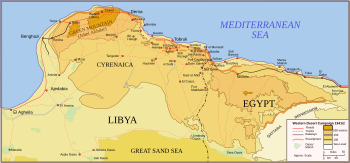
In North Africa, the Italian invasion of Egypt started in September 1940. The British Western Desert Force had about 36,000 men. They faced many more Italian troops in Libya and East Africa. The British responded with Operation Compass in December, which was a big success.
1941: Turning Points and Retreats
Operation Compass was a success, and the British captured many Italian soldiers and equipment. However, Germany sent the Afrika Korps to reinforce the Italians. This German force, led by Erwin Rommel, pushed the British and Commonwealth forces back. Many British generals were captured.
The British launched Operation Brevity and Operation Battleaxe to try and push back, but they failed. Winston Churchill then changed the command. The British Eighth Army was formed and launched Operation Crusader, which was a success. This was the first victory over the Germans by British-led forces in the war.
The British also fought in the Battle of Greece and the Battle of Crete. Many troops had to be evacuated, and thousands were captured. The Anglo-Iraqi War and the Syria-Lebanon Campaign also took place in the Middle East. The Anglo-Soviet invasion of Iran secured oil fields and supply lines.
In South-East Asia, the Battle of Hong Kong began in December 1941. After 17 days, Hong Kong surrendered to the Imperial Japanese Army. The Japanese invasion of Malaya also started in December, leading to the fall of Singapore.
1942: Major Setbacks and Key Victories
In the Far East, Singapore surrendered in February 1942. About 100,000 British and Commonwealth troops became prisoners of war. Churchill called it the "worst disaster" in British history. The Japanese conquest of Burma also began, forcing British and Indian troops to retreat.
In North Africa, Axis forces attacked in May, defeating the Allies at the Battle of Gazala and capturing Tobruk. The Eighth Army retreated to the Egyptian border. After some changes in command, Bernard Montgomery took command of the Eighth Army. In October, the Second Battle of El Alamein was a huge victory for the British, decisively defeating the Axis forces.
The Dieppe Raid in France in August was a difficult landing that resulted in heavy casualties. However, lessons learned from Dieppe helped the British develop special vehicles for later landings, like those in Normandy.
In November, Operation Torch was launched in French North Africa. British forces landed in Algiers. This led to the Tunisian Campaign, where the British First Army faced strong Axis resistance.
The Battle of Madagascar was launched in May to prevent Japanese forces from capturing Vichy French-controlled Madagascar.
1943: North Africa and Italy
In January 1943, German and Italian troops retreated into Tunisia. The British First and Eighth Armies attacked them. After fierce fighting, the Axis supply lines were cut. In May, the British captured Tunis, and by May 13, Axis forces in Tunisia surrendered, with 230,000 prisoners.
The Italian Campaign followed. First, the Allied invasion of Sicily in July. The Eighth Army landed with the American Seventh Army. The Eighth Army faced tough resistance on Mount Etna, allowing the American forces to reach Messina first.
On September 3, Montgomery's Eighth Army landed in Italy, and Italy surrendered on September 8. The main landing by the American Fifth Army, including British X Corps, took place at Salerno. The Germans fought back fiercely. The British also landed at Taranto by sea. Naples was reached in October. By the end of the year, the Allies were still short of Rome.
In Burma, Brigadier Orde Wingate and his Chindits (the 77th Indian Infantry Brigade) went deep behind Japanese lines in February. They caused damage to Japanese communications but suffered heavy losses.
1944: Normandy and Beyond
The Allied invasion of Normandy happened on June 6, 1944. British divisions landed on Gold Beach and Sword Beach. The British 6th Airborne Division landed before the main invasion to secure key areas. The British fought hard in the Battle for Caen, suffering many losses before capturing the city in July.
The 21st Army Group, led by Bernard Montgomery, helped trap German armies in the Falaise Pocket, capturing about 50,000 German prisoners. The Battle of Normandy ended in August. The British also played a small part in the invasion of Southern France in August.
After the German armies were largely destroyed, the British Guards Armoured Division liberated Brussels in Belgium on September 3. The British 11th Armoured Division liberated the port of Antwerp the next day.
On September 17, Operation Market Garden began. British XXX Corps provided ground forces, and the British 1st Airborne Division took part in a large airborne assault in the Netherlands. The plan was to capture bridges over rivers to allow a quick advance into Germany. However, the ground forces were delayed, and the 1st Airborne Division was effectively destroyed at Arnhem.
The Battle of the Scheldt in October and November involved British and Canadian forces clearing the way to use the port of Antwerp. The Battle of the Bulge was mainly an American battle, but British XXX Corps helped. Montgomery was in overall command of the northern sector.
In Italy, the fighting was very hard. The Allies faced the strong Winter Line and fought the difficult Battle of Monte Cassino. The Anzio landings in January tried to bypass the German defenses by sea, but a stalemate followed. When the Allies finally broke through, they advanced towards Rome. By December, they had reached Ravenna.
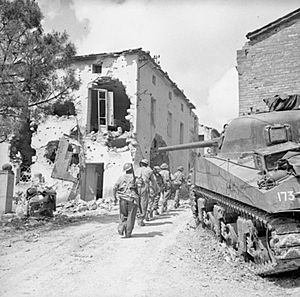
The 1944 campaign in Burma included Operation Thursday, where Chindit forces disrupted Japanese supply lines. The Battle of the Admin Box in February was the first time British and Indian troops held and defeated a major Japanese attack. This was followed by big victories at the Battle of Imphal and the Battle of Kohima, which were the Japanese army's biggest land defeats of the war.
1945: The Final Push
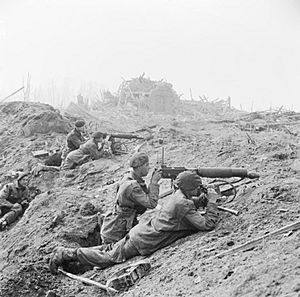
In Germany, the 21st Army Group began its push towards the Rhine in February. On March 23, the Second Army crossed the Rhine, supported by a large airborne assault. The British advanced across the North German Plain towards the Baltic sea. By May 4, all German forces in Denmark, the Netherlands, and northwest Germany surrendered to Montgomery.

In Italy, the final offensive began on April 9. The Eighth Army broke through German lines and captured Bologna. By the end of April, Axis forces in Italy had lost most of their power and surrendered on May 2, 1945.
In Burma, the Battle of Meiktila and Mandalay began in January. Most of the Japanese forces were destroyed, allowing the Allies to capture the capital, Rangoon, on May 2. The British Army fought its last major land battle of the war in July, when remaining Japanese forces tried to break out. This ended in a crushing defeat for the Japanese. Japan surrendered on August 14, along with Hong Kong.
Casualties
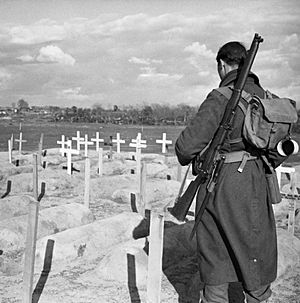
By November 1945, the British government reported that the British Empire had suffered over 1.2 million casualties between September 1939 and August 1945. Of these, 755,257 were from the United Kingdom. The British military had 244,723 killed, 53,039 missing, 277,090 wounded, and 180,405 taken as prisoners of war. Later reports in 1961 showed that the British Army alone had 569,501 casualties, including 144,079 killed and 152,076 captured.
Images for kids
-
Battle Area of the Western Desert Libya and Egypt.
See also



